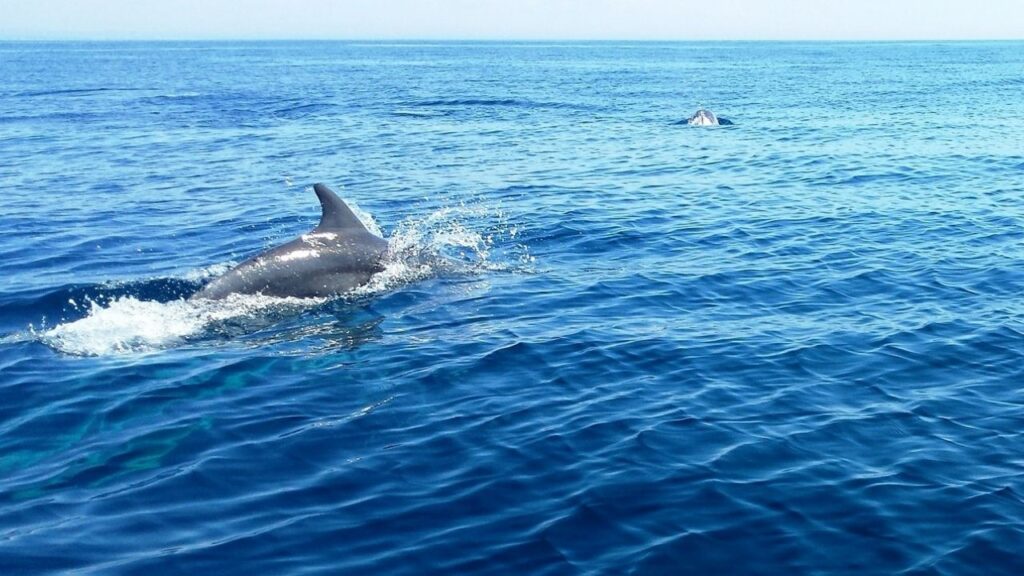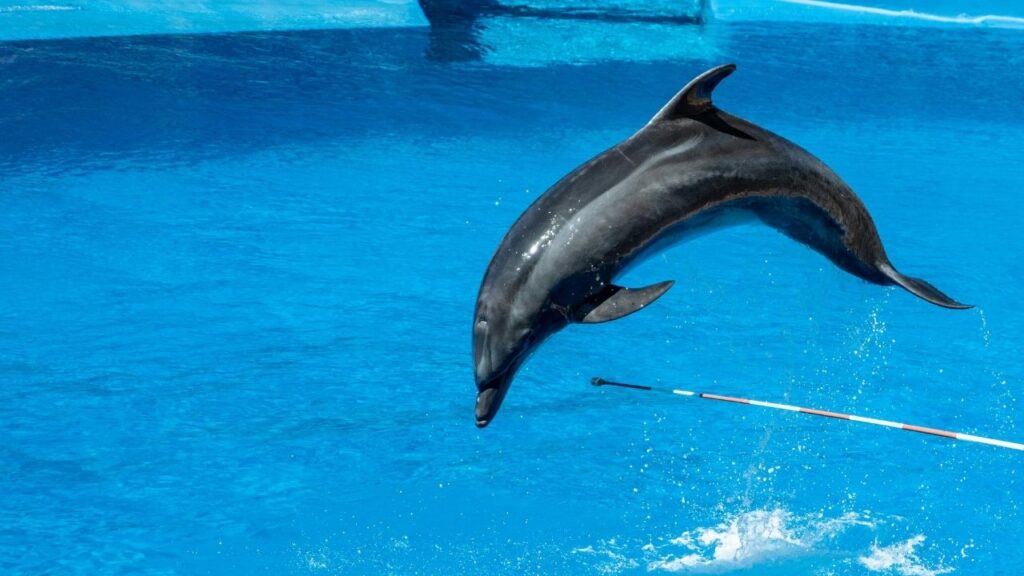
Can Dolphins Swim Backwards? Dolphins cannot swim backwards due to the structure of their spine and muscle arrangement.
Dolphins, with their playful nature and impressive acrobatics, have long fascinated both marine biologists and the general public.
One fascinating aspect of dolphin behavior is their movement. While these intelligent marine mammals are known for their graceful forward swimming and spectacular jumps, a common question arises: can dolphins swim backwards?
In this article, we’ll delve into the biomechanics of dolphin movement, explore the reasons behind their swimming patterns, and answer some frequently asked questions about these incredible creatures.
Table of Contents
Anatomy of Dolphin Movement
Dolphins are built for speed and agility in the water.
Their streamlined bodies, powerful tails, and flippers enable them to move swiftly and with great precision. The key to their movement lies in their muscular and skeletal structure.
Unlike many fish, dolphins have a vertical tail fin (fluke) that moves up and down, rather than side to side.
This unique feature, combined with a flexible spine, allows them to propel themselves forward with remarkable efficiency.
The streamlined body of a dolphin reduces drag, allowing it to cut through the water with minimal resistance.
Their muscular tails, which end in the fluke, generate powerful thrusts with each up-and-down motion.
This movement is much different from the side-to-side tail movements seen in most fish.
The flexibility of the dolphin’s spine also plays a crucial role, as it enables the dolphin to achieve the undulating motion needed for swift forward propulsion.
Dolphins also have a layer of blubber beneath their skin, which provides buoyancy and energy reserves. Their skin is smooth and rubbery, further reducing friction as they swim.
Together, these anatomical features make dolphins some of the most efficient swimmers in the ocean.

Why Dolphins Can’t Swim Backwards
Despite their impressive forward movement, dolphins are unable to swim backwards. This limitation is due to the structure of their spine and muscle arrangement.
The dolphin’s spine is designed to facilitate powerful forward propulsion but lacks the flexibility for reverse movement. [Can Dolphins Swim Backwards?]
Additionally, the up-and-down motion of their tail fin does not support backward swimming.
Attempting to swim backwards would require a fundamentally different muscular and skeletal design, which dolphins do not possess.
Spine Structure and Motion Range
The vertebrae in a dolphin’s spine are connected to allow significant motion up and down but very little side-to-side.
This design is perfect for forward swimming, as it provides the necessary support and flexibility for their powerful tail strokes. However, it does not permit the same range of motion in reverse.
| Feature | Forward Movement | Backward Movement |
| Spinal Flexibility | High up-and-down flexibility | Limited side-to-side flexibility |
| Tail Fin Movement | Up-and-down propulsion | Not designed for reverse motion |
| Muscle Orientation | Optimized for forward thrust | Ineffective for reverse propulsion |
Muscle Orientation
The muscles that drive the tail fluke are oriented to maximize forward thrust. These muscles are not capable of effectively generating the reverse motion needed to propel the dolphin backward.
This orientation is essential for the powerful, efficient forward strokes that dolphins use to swim at high speeds. [Can Dolphins Swim Backwards?]
The combination of these anatomical factors means that while dolphins excel in forward movement, they are fundamentally incapable of swimming backwards.
Their bodies are optimized for swift, agile forward propulsion, ensuring they remain some of the ocean’s most adept and efficient swimmers.
See Also: Can You Swim With Dolphins In Kauai?

The Role of the Dolphin’s Flippers
While dolphins can’t swim backwards, their flippers play a crucial role in maneuverability.
The pectoral flippers, located on either side of their body, act like rudders, helping dolphins steer and make sharp turns.
These flippers also aid in stabilizing the dolphin’s body as it moves through the water. By adjusting the angle of their flippers, dolphins can perform complex movements, such as spinning and turning, with ease.
The pectoral flippers are supported by a modified bone structure similar to that of a human hand, which provides the dexterity needed for fine control.
When a dolphin wants to change direction, it tilts one flipper while keeping the other steady, allowing it to pivot and turn.
This capability is crucial for chasing prey, avoiding obstacles, and engaging in social interactions with other dolphins.
The flippers also assist with braking. Dolphins can slow down quickly by spreading their flippers wide and angling them against the direction of travel.
This feature is especially useful when they need to make sudden stops to catch fast-moving prey or to navigate through tight spaces in coral reefs or kelp forests.
Dolphin Behavior and Movement Patterns
Dolphins are known for their playful behavior, often seen leaping out of the water, riding waves, and performing acrobatic feats.
These activities are not just for fun; they also serve practical purposes. Leaping and breaching can help dolphins spot prey, communicate with other dolphins, and remove parasites from their skin.
The ability to make quick, agile movements is essential for hunting and evading predators. [Can Dolphins Swim Backwards?]
Leaping out of the water, known as breaching, allows dolphins to get a better view of their surroundings, both above and below the water surface.
This behavior can help them locate schools of fish or other potential prey. It also serves as a way to communicate with other dolphins, as the splash created by a breach can be seen and heard over long distances.
Wave riding is another common behavior where dolphins surf on the waves created by boats or large marine animals.
This activity conserves energy, as the dolphins can be carried along by the wave without expending much effort.
It’s also believed to be a social activity, as dolphins often engage in wave riding together, strengthening social bonds within the pod.
Research and Observations
Marine biologists have conducted extensive research on dolphin movement to understand the mechanics behind their swimming abilities.
Studies using underwater cameras and tracking devices have provided valuable insights into how dolphins navigate their environment.
Observations in the wild and in captivity have shown that while dolphins can perform a wide range of movements, swimming backwards is not one of them.
Advanced technology has allowed researchers to study dolphins in greater detail. High-speed cameras capture the intricate movements of dolphins’ tails and flippers, while satellite tags track their long-distance migrations.
These studies have revealed the efficiency of dolphin swimming and how they optimize their movements to conserve energy. [Can Dolphins Swim Backwards?]
Research in captivity has provided additional insights. Dolphins in aquariums and marine parks are often trained to perform various maneuvers, giving scientists a controlled environment to study their movements.
Despite these conditions, no evidence has been found to suggest that dolphins can swim backwards.
Instead, these studies reinforce the understanding of dolphin biomechanics and the evolutionary adaptations that make them such skilled swimmers.
FAQs
Can any marine mammals swim backwards?
While most marine mammals, including dolphins, cannot swim backwards, some exceptions exist. For instance, sea otters can move backwards using their webbed feet and tails.
Do dolphins ever need to swim backwards?
In their natural environment, dolphins do not need to swim backwards. Their forward movement, agility, and ability to turn quickly suffice for their needs.
How do dolphins steer if they can’t swim backwards?
Dolphins use their pectoral flippers to steer and make sharp turns. By adjusting the angle of their flippers, they can change direction quickly and efficiently.
What enables dolphins to swim so fast?
Dolphins’ streamlined bodies, powerful tails, and flexible spines allow them to swim at high speeds, often reaching up to 20 miles per hour.
Can dolphins perform other unique movements?
Yes, dolphins can perform a variety of unique movements, such as spinning, leaping, and riding waves. These behaviors are not only playful but also serve practical purposes.
Conclusion: Can Dolphins Swim Backwards?
While dolphins cannot swim backwards, their forward movement is a marvel of nature’s engineering.
The unique anatomy and muscular structure of dolphins enable them to navigate the water with speed and agility, making them one of the most fascinating creatures in the ocean.
Understanding the limitations and capabilities of dolphin movement not only deepens our appreciation for these incredible animals but also highlights the intricate design of marine life.
As we continue to study and observe dolphins, we uncover more about their behaviors and the mysteries of the underwater world.

Mr. Das, a certified pharmaceutical scientist, holds a Bachelor of Science in Pharmaceutical Sciences and passionately contributes to dolphin conservation as a member of the committee in Bangladesh.


